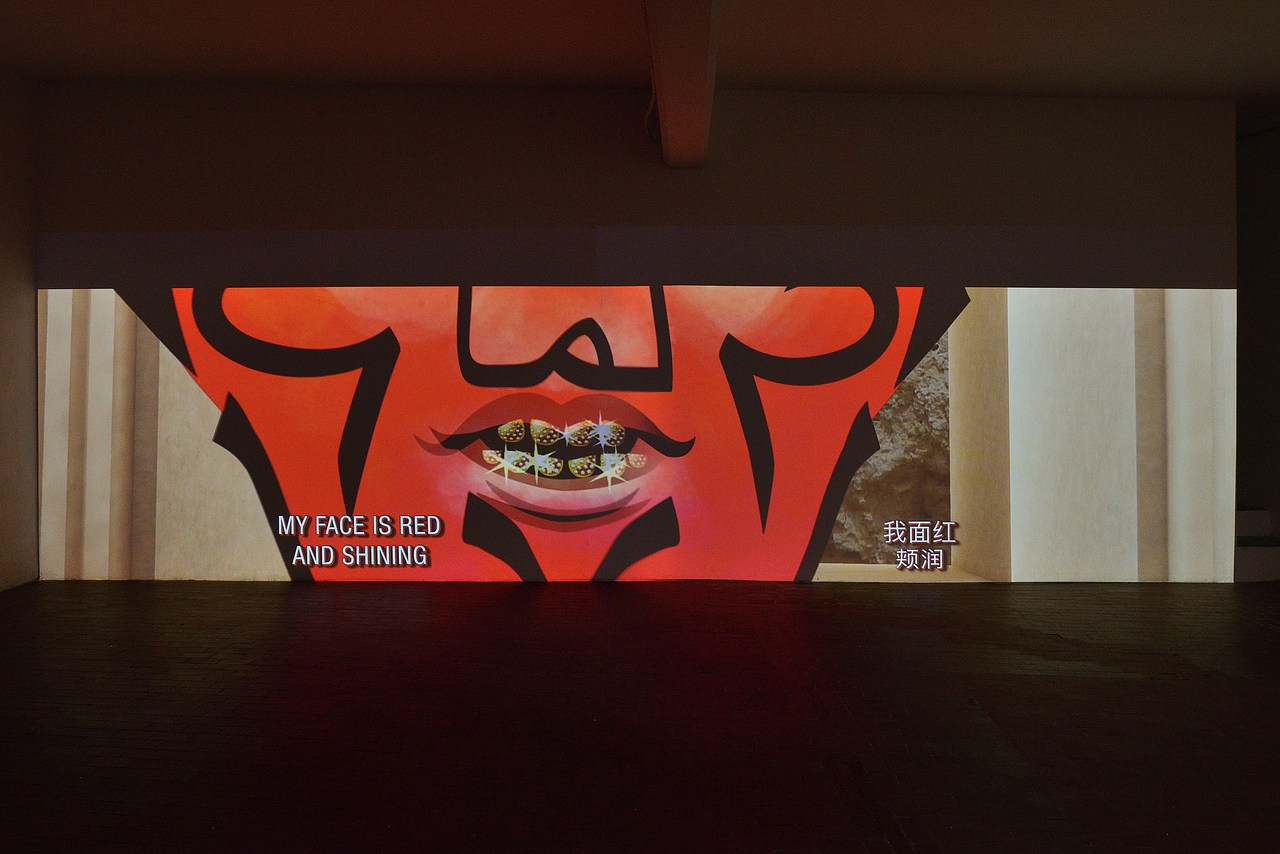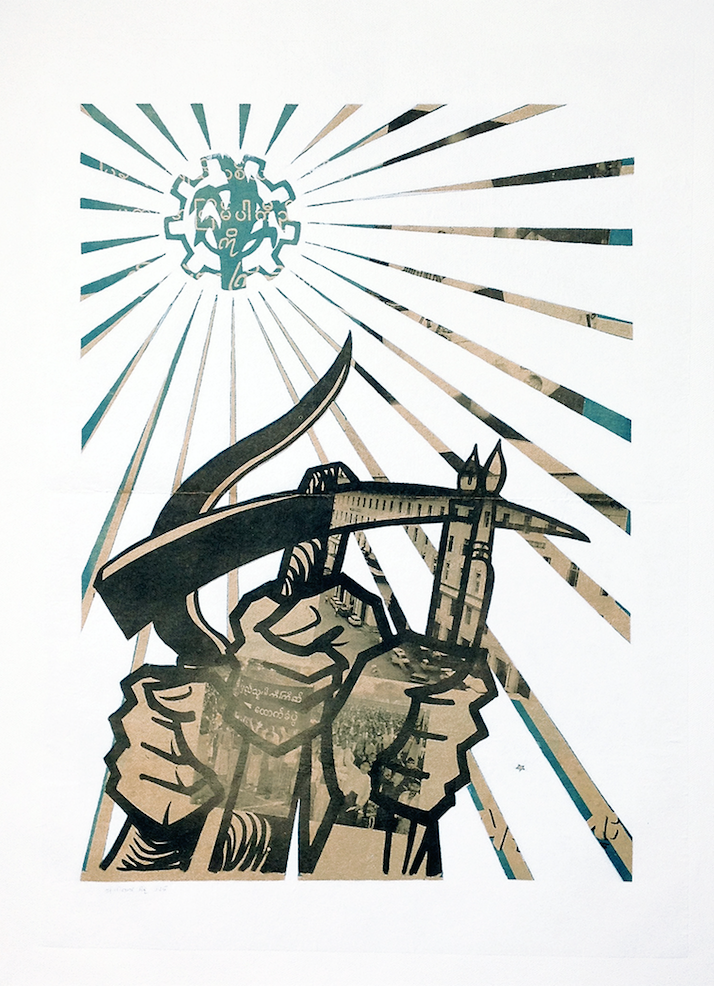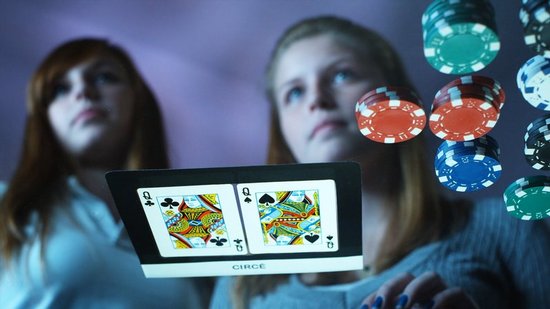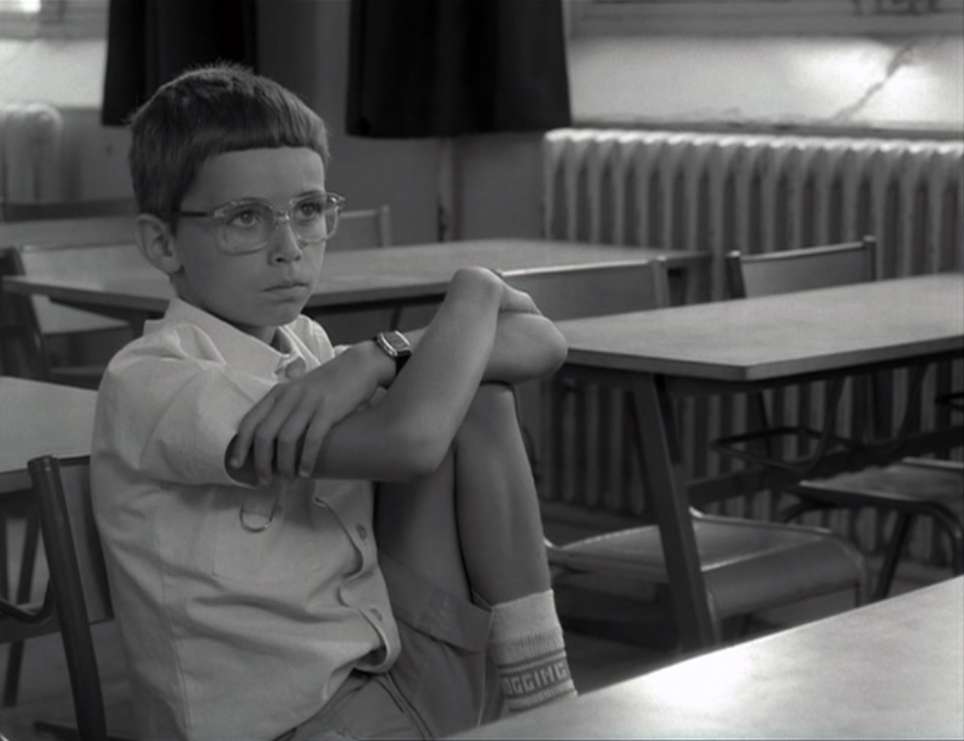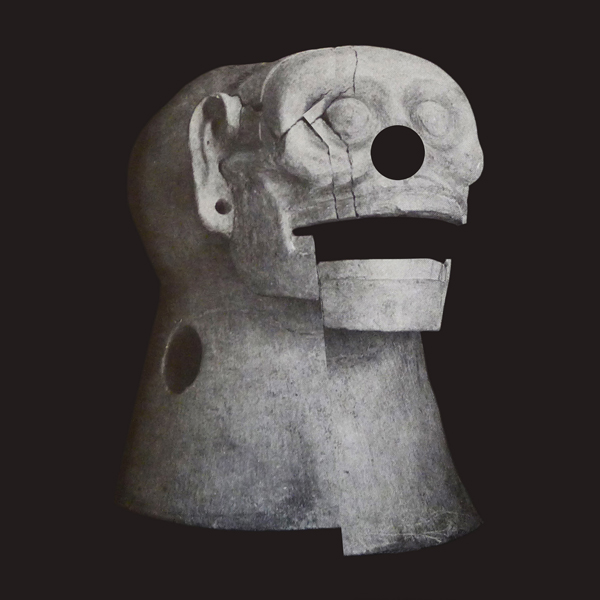
© » KADIST
Pauline Boudry and Renate Lorenz
Salomania sees choreographer and filmmaker Yvonne Rainer and artist Wu Tsang rehearse scenes from Valda’s Solo , a chapter of a film Rainer made in 1972 after having seen women perform the dance of the seven veils in Alla Nazimova’s 1923 silent film Salomé . The script is based on the Biblical New Testament story of the Jewish princess Salomé, who in the Christian tradition has been depicted as an emblem of feminine seduction and danger. In the twentieth century, her character was made popular through English playwright Oscar Wilde’s famous theater piece, Salomé .

© » KADIST
Renata Lucas
Lucas’s quadroquadro (círculo) employs familiar materials for the artist: wood, paper, and glass. A simple composition—a black circle inscribed on white paper, encased in a rectangular frame—is interrupted in Lucas’s work, the continuous geometry of the nested forms segmented into four broken shards. Pieced back together, these fragments comprise a whole, but it is a unity shattered, unsteadied.

© » KADIST
Aline Baiana
Indigenous educator and curator Sandra Benites, of the Guarani-Ñandeva people, narrates the origin myth of the bird Urutau in her native language. This nightjar stands still on a branch all day long and, at dusk, cries a low hoot resembling a human weeping. In 2013, indigenous activist José Urutau Guajajara remained on the top of a tree for 26 hours, deprived of food and water by state forces.

© » KADIST
Renee Rhodes
The artist writes about her work: “There is an endless desire to know what we look like from outer space and many of us have evolved into a species that exists across the disorienting spaces and timeframes of virtuality. Within my current work, dance and simple movement scores act as a language for simultaneously collecting, mapping and producing volumes of information and knowledge. Moving makes a map and performing is observation.

© » KADIST
Ulrik López
Addressing the 1966 XVII World Chess Olympics, Pataki 1921 by Ulrik López continues the artist’s interest in chess as a subject and as a symbol for various world affairs and political confrontations. Pataki 1921 is an installation that derives from and expands on Cuban choreographer Alberto Alonso’s ballet piece titled La partida viviente (The Living Match) which opened the Olympic. The choreography recreates the 1921 World Championship chess match where the Cuban player José Raúl Capablanca won the world title against the German master Emmanuel Lasker, becoming the first Latin-American, but more precisely Caribbean, player to win this title.

© » KADIST
Mateo Lopez
With Roca Carbón (Charcoal Rock, 2012) and Roca Grafito ( Graphite Rock , 2012), López plays with our relationship to inert and unremarkable objects such as rocks. Traces of art history reverberate through the sculptures; their mediums reflect traditional materials for drawing and sketching, and the simplicity of their forms gesture toward minimalism. But López dislocates these common objects from their ordinary utility by replicating their component parts in paper, graphite, and charcoal, thus drawing attention to mechanisms of representation and translation.

© » KADIST
Oren Pinhassi
Oren Pinhassi’s work examines the relationship between the human figure and the built environment. His hybrid sculptures, often somewhat emaciated, hover between the figurative and the architectural. In the case of The Crowd , a series of sculptures which evince architectures of control – where humans act and exert power – we find voting booths, segregation cells, institutional desks, places where bureaucratic exchange become spaces of bodily desire, complete with sexual appendages.

© » KADIST
Gabriella and Silvana Mangano
There is no there by Gabriella and Silvana Mangano is a black and white looped video with sound, in conjunction with a live performance. The work is inspired by the Blue Blouse, a political propaganda theater movement which spread across the Soviet Union in the mid-1920s. More specifically, the work takes the form of ‘Living Newspapers’, which were performances based on topical news events.

© » KADIST
Slavs and Tatars
Wheat Mollah ( 2011) is one of Slavs and Tatars composite object. The title Wheat Mollah has various interpretations, from “master” or spiritual authority for Shiites and “friend” for Sunnis. The turban is also worn in a diversity of cultures and religions in Africa, Asia and India.

© » KADIST
Michelle and Noel Keserwany
Les Chenilles by Michelle and Noël Keserwany is a sensual film that translates the source of women’s oppression into the means for their liberation. In this narrative film, protagonists Asma and Sarah meet while working as waitresses in France. They both come from the Levant and, each in their own way, carry burdens of the past and the consequences of colonialism.
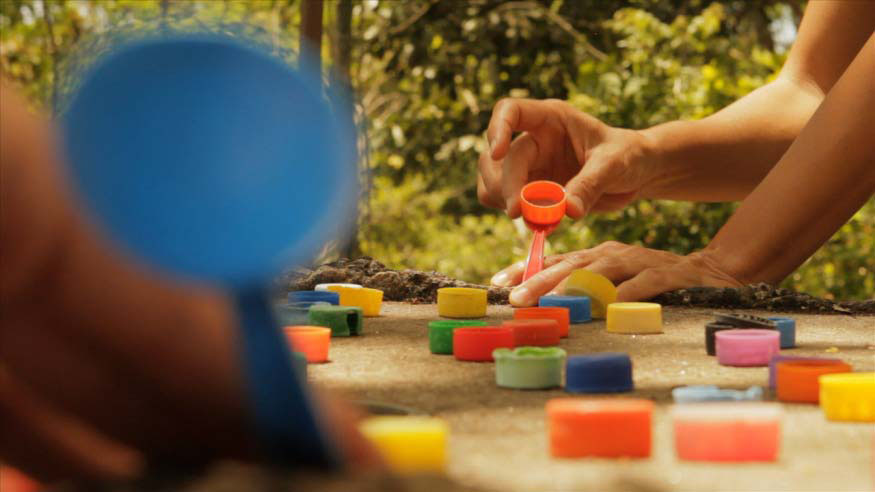
© » KADIST
Donna Conlon and Jonathan Harker
In Tapitapultas (2012), Donna Conlon and Jonathan Harker comment on mass consumerism and pollution by way of a game they invented. The artists used disposable spoons as catapults to shoot thousands of plastic bottle caps at a hole in a concrete platform. The platform was once part of a U. S. military installation in the Panama Canal Zone, and it is now an observation deck in a nature park.

© » KADIST
Köken Ergun and Tashi Lama
Nepal and China signed an agreement for the Belt and Road Initiative (BRI) in 2017. The BRI is a strategy that was set forth by China in 2013 to expand its influence by building a network of economic corridors around the globe. BRI projects in Nepal include the Kathmandu-Kerung Railway, the Galchhi-Rasuwagadhi-Kerung 400 kilovolt transmission line, the 762 megawatt Tamor hydroelectric dam, and the 426 megawatt Phukot Karnali run-of-the-river hydropower project.

© » KADIST
Jay Chung and Takeki Maeda
Jay Chung and Q Takeki Maeda remake a clip from the 1970s they found on the internet, and without really changing this archive material, displace it by imitating the staging and the acting with scrupulous precision. The slightest details are reproduced identically with great minutiae. The facial expressions are absurd, the prim attitude makes no sense.

© » KADIST
Pooja Gurung and Bibhusan Basnet
DADYAA: The Woodpeckers of Rotha by Pooja Gurung and Bibhusan Basnet illuminates a unique and seldom seen international perspective on indigenous cultures and contemporary social issues in the Nepali context. A small masterpiece, the work engages with one of the most pressing social issues in Nepal, mass migration and the dissolving of social fabric in rural areas. The story begins with an old couple, Atimaley and Devi, who live in a village in Jumla, in the highlands of Western Nepal.

© » KADIST
Musquiqui Chihying and Gregor Kasper
Addressing the legacy of colonialism, The Guestbook by Musquiqui Chihying and Gregor Kasper is a slow-paced, black-and-white film exploring the German colony of Togoland, now the Republic of Togo. The guestbook in question—a thin, battered copy that Do Do, the Togolese protagonist of the film, finds in Berlin’s State Library—is filled with the signatures of colonial-era explorers. The plot follows Do Do as he seeks out Treptower Park, where the JAZZ musician Kwassi Bruce was once exhibited in a human zoo in the first German Colonial Exhibition.

© » KADIST
Jonas Van and Juno B
Jonas Van and Juno B’s video work Kebranto is anchored by the figure of Boitatá, a snake that is part of the imaginary Guaraní communities that live between the current nation-states of Argentina, Brazil, Paraguay, and Uruguay. The mythical figure Boitatá is a protector of jungles and forests. In GuaraníBoitatá is the union of two words: Mbói (snake) and tatá (fire).

© » KADIST
Köken Ergun and Satyam Mishra
Nepal and China signed an agreement for the Belt and Road Initiative (BRI) in 2017. The BRI is a strategy that was set forth by China in 2013 to expand its influence by building a network of economic corridors around the globe. BRI projects in Nepal include the Kathmandu-Kerung Railway, the Galchhi-Rasuwagadhi-Kerung 400 kilovolt transmission line, the 762 megawatt Tamor hydroelectric dam, and the 426 megawatt Phukot Karnali run-of-the-river hydropower project.

© » KADIST
Angela Detanico and Rafael Lain
Letters of the Greek alphabet glisten on a black background. When a letter appears, there is a sound. Each letter corresponds to a star in the sky.

© » KADIST
Raimond Chaves and Mantilla Gilda
Many of Chaves and Gilda’s works use recycled cardboard. For Partituras, they arranged stacks of cardboard into long rectangles on the ground, which are visually analogous to fields of graphite in Chaves’s pencil drawings. While the blocks have a spare presence in space, they exist more full solidity within their borders, and the recycled nature of the cardboard adds some play into the clean minimalist rectangles and cubes.

© » KADIST
Chantal Edie and Zacharie Ngnogue
Au non de la liberté (Tiko drink Kumba drunk) is a photographic series by Zacharie Ngnogue and Chantal Edie that considers the correlation between those who hold power in Cameroon and how their actions affect the populations they rule in often compromising ways. “Tiko drink-Kumba drunk” is an adage that is commonly used in the Southwest province of Cameroon to speak of how one’s actions affect others. Civil liberties are next to non-existent in Cameroon, the law is lawless, and structured in a way that is intended to attack its citizens’ human rights.

© » KADIST
Chantal Edie and Zacharie Ngnogue
Au non de la liberté (Tiko drink Kumba drunk) is a photographic series by Zacharie Ngnogue and Chantal Edie that considers the correlation between those who hold power in Cameroon and how their actions affect the populations they rule in often compromising ways. “Tiko drink-Kumba drunk” is an adage that is commonly used in the Southwest province of Cameroon to speak of how one’s actions affect others. Civil liberties are next to non-existent in Cameroon, the law is lawless, and structured in a way that is intended to attack its citizens’ human rights.

© » KADIST
Mateo Lopez
Mateo Lopez uses paper as a medium to conjure personal experiences. The artist creates drawings and trompe l’oeil objects, ranging from apples to clothing hangers to doors. These props are part of a performance; he often sets up his studio in public and uses cues from his own journeys as the inspiration for his work.

© » KADIST
Mateo Lopez
With Roca Carbon ( Charcoal Rock , 2012) and Roca Grafito ( Graphite Rock , 2012), López plays with our relationship to inert and unremarkable objects such as rocks. Traces of art history reverberate through the sculptures; their mediums reflect traditional materials for drawing and sketching, and the simplicity of their forms gesture toward minimalism. But López dislocates these common objects from their ordinary utility by replicating their component parts in paper, graphite, and charcoal, thus drawing attention to mechanisms of representation and translation.

© » KADIST
Jazmín López
Shot on 35mm in two simply framed shots, Jazmín López’s Juego Vivo captures children at play, mixing imagination, reality, innocence, and violence. Set within a lush, green forest, we see first several children come into the frame, walking towards us, as a disembodied voice counts off “Tres…cuatro…cinco…” A game of hide and seek is at hand, and sounds of the girl counting are met with scattering children. In the first shot, while everyone else disperses, one boy advances steadily toward the camera, holding a scavenged stick in his hands, wielding it like a gun.

© » KADIST
Ana Vaz
Há Terra! (There Is Land!) is a short film by Ana Vaz that picks up on the artist’s previous film A Idade da Pedra (2013), in which Vaz imagined premodernity in her native Brazil.

© » KADIST
Lenka Clayton and Phillip Andrew Lewis
Five Hundred Twenty-Four, a single-channel video installation by Lenka Clayton and Phillip Andrew Lewis, features singers from over twenty Cleveland-area choirs counting numbers in an iterative process: one person sings “one”, then two people sing “two”, and so forth, to 524. Each choir was filmed separately, and the artists weave together the audio while the video features each choir individually. The juxtaposition of different contexts in which singing occurs functions as an embedded sociological study of various communities throughout the region.

© » KADIST
Jane Jin Kaisen and Guston Sondin-Kung
The Woman, The Orphan, and The Tiger begins with the sound of women’s voices describing histories of violence, of things repressed and silenced. Gradually, their voices accumulate into a cacophony of pure sonic intensity against an extreme slow-motioned image of a woman survivor of Japan’s military sexual slavery who, in the absence of words to accurately account for her suffering, gets up and walks into the center of a war crimes tribunal court room and gestures wildly before she faints. This work by Jane Jin Kasen and Guston Sondin-Kung explores ways in which trauma is passed on from previous generations to the present through a sense of being haunted.

© » KADIST
Etel Adnan and Lynn Marie Kirby
Drawing & Print (Drawing & Print)
In conjunction with KADIST’s 2017 exhibition If Not Apollo, the Breeze , artist and filmmaker Lynn Marie Kirby performed Transmissions , a video and live reading created with longtime collaborator Etel Adnan. Inspired by time spent together in Paris, the piece incorporated open-ended conversation about the oracle, Mount Tamalpais (a subject of long-standing fascination for Adnan and the subject of hundreds of works), and a suite of collaborative drawings. The drawings, made in India ink and created spontaneously, are remarkable evidence of two lives, minds, and hands in dialogue.

© » KADIST
Leung Chi Wo and Wong Sara
Photojournalist with Two Cameras restages a portrait of a photojournalist from the background of an old photograph of protest published in South China Morning Post on January 10, 2010 under the headline “Return of the Radicals: Recent angry protests are nothing new.” The photojournalist in the photograph, probably from a protest of earlier decades, was capturing the scene of a protester’s arrest while wearing two cameras. January of 2010 was a time of pro-Democracy demonstrators called for the release of activist Liu Xiaobo, drafter of the Charter 08 manifesto calling for the end of authoritarian rule, was sentenced to 11 years in prison one month earlier. Leung’s isolating and highlighting of the photographer by bringing him from the original photograph’s background to the foreground of his studio shot calls attention to the two older cameras and the journalist’s retro-style clothing.
Mateo Lopez
- location: Bogota, Colombia
- year born: 1978
- gender: male
- nationality: Colombian
- home town: Bogota, Colombia
Chantal Edie and Zacharie Ngnogue
Chantal Edie and Zacharie Ngnogue are a photography duo who channel their personal experiences into social commentaries...
Mary Ann Aitken
Mary Ann Aitken was known to be very private about her art practice; she was considered somewhat of an outsider by her peers affiliated with the second wave of Detroit’s Cass Corridor arts movement...
John Wood and Paul Harrison
John Wood and Paul Harrison have been working collaboratively since 1993, producing single screen and installation-based video works...
Leung Chi Wo and Wong Sara
Leung Chi Wo tends to highlight in his art the boundaries between viewing and voyeurism, real and fictional, and art and the everyday...
An-My LE
- location: New York, New York
- year born: 1960
- gender: female
- home town: Saigon, Vietnam
Ana Vaz
Ana Vaz is an artist and filmmaker whose works speculate on the relationships between self and other, and myth and history, through a cosmology of signs, references, and perspectives...
Ho Rui An
The artist, writer, and researcher Ho Rui An probes histories of globalization and governance, performing a detournement of dominant semiotic systems across text, film, installation, and lecture...
Ad Minoliti
Ad Minoliti is a painter who combines the pictorial language of geometric abstraction with the perspective of queer theory...
Renee Rhodes
Renée Rhodes grew up amidst the fantasy and rigor that is the world of classical ballet...
Aline Baiana
Aline Baiana’s work is informed by extensive theoretical and field research on indigenous, feminist, ethnic, environmental, and social justice matters...
John Lucas and Claudia Rankine
John Lucas and Claudia Rankine are interdisciplinary thinkers and makers committed to exploring the nuances of race and power in our daily lives...
Gabriella and Silvana Mangano
Gabriella Mangano and Silvana Mangano are an artistic duo and identical twins known for their collaborative and performative video practice...
Tun Win Aung and Wah Nu
Wah Nu and Tun Win Aung, respectively born in 1977 and 1975, Yangon, Myanmar...
Donna Conlon and Jonathan Harker
- location: Panama City, Panama
- year born: 1966
- nationality: American and Ecuadorian
Lenka Clayton and Phillip Andrew Lewis
Lenka Clayton and Phillip Andrew Lewis’s collaborative practice is social at its core: it engages with and connects communities outside of the so-called art world in both production and presentation...
Angela Detanico and Rafael Lain
Linguists, semiologists, and graphic designers by training, Angela Detanico and Raphaël Lain consider the use of graphic signs in society...
Christine Sun Kim and Thomas Mader
Christine Sun Kim and Thomas Mader have been collaborating for the last 5 years, covering communication in a variety of formats such as recording an overnight shipment from Berlin to New York ( Recording Contract , 2013), compiling 24 hours of invited contributors’ studio time ( Busy Day , 2014), and using the arm game, a combination of body and face, in order to describe a series awkward situations ( Classified Digits , 2016)....
Etel Adnan and Lynn Marie Kirby
Visual artist, poet, and essayist Etel Adnan writes what must be communicated through language, and paints what cannot...
Renata Lucas
Brazilian artist Renata Lucas is interested in the social, behavioral, and aesthetic implications of special constructions...
Ana Navas
Ana Navas’s practice deals with the vulgarization of modern art, understanding the term vulgar in its original sense of being appropriated by common people...
Musquiqui Chihying and Gregor Kasper
Through his artistic career, Musquiqui Chihying has striven to dislocate and reconstruct established modes of behavior within systems and structures of power...
Olive Martin and Patrick Bernier
Patrick Bernier and Olive Martin are a duo of artists collaborating since 1999...
Pauline Boudry and Renate Lorenz
Working together since 2007, artist duo Pauline Boudry and Renate Lorenz conduct research on the heritage of cultural and gender studies, concentrating primarily on gender discourses and the notion of queer...
The Propeller Group and Superflex
The Propeller Group was established in 2006 as a cross-disciplinary structure...
Jordan Ann Craig
Jordan Ann Craig is a Northern Cheyenne artist born and raised in the Bay Area; she invests her work with a strong interest in Indigenous culture and the history of its destruction by settlers...
Raimond Chaves and Mantilla Gilda
The collaborative works of Raimond Chaves and Mantilla Gilda often derive from a direct engagement with the world...
Oren Pinhassi
Oren Pinhass’s practice integrates architecture and sculpture in the making of fantastical forms, employing found objects as well as replicating such objects in various media...
Maayan Amir and Ruti Sela
Maayan Amir and Ruti Sela, two young Israeli women artists work collaboratively or individually by project...

© » APERTURE
about 5 months ago (12/01/2023)
For the past two decades, An-My Lê has used photography to examine her personal history and the legacies of US military power, probing the tension between experience and storytelling....
-
1980-1989
Jean-Marie Straub and Danièle Huillet
1982En rachâchant is based on the short story Ah! Ernesto! (1971) by Marguerite Duras in which the child Ernesto does not want to go to school anymore as all that he is taught are things he does not know...
-
1990-1999
John Wood and Paul Harrison
1996One of John Wood and Paul Harrison’s earliest works, Device features Harrison performing a series of actions, assisted by the titular ‘devices’, that use physics to force his body into unusual and uncomfortable positions...
John Wood and Paul Harrison
19973-Legged is an early video work by John Wood and Paul Harrison in which they appear with their legs tied together (as one would do in a three-legged race)...
-
2000-2009
Mary Ann Aitken
2002Untitled (Boom Box, Double-Sided) by Mary Ann Aitken is representational painting of a boom box on an unconventionally long canvas painted on both sides, to mimic the scale and appearance of the actual appliance...
Maayan Amir and Ruti Sela
2003In Beyond Guilt the two artists create a portrait of our generation in three parts...
Jazmín López
2008Shot on 35mm in two simply framed shots, Jazmín López’s Juego Vivo captures children at play, mixing imagination, reality, innocence, and violence...
Pauline Boudry and Renate Lorenz
2009Salomania sees choreographer and filmmaker Yvonne Rainer and artist Wu Tsang rehearse scenes from Valda’s Solo , a chapter of a film Rainer made in 1972 after having seen women perform the dance of the seven veils in Alla Nazimova’s 1923 silent film Salomé ...
Jay Chung and Takeki Maeda
2009Jay Chung and Q Takeki Maeda remake a clip from the 1970s they found on the internet, and without really changing this archive material, displace it by imitating the staging and the acting with scrupulous precision...
Mary Ann Aitken
2009Untitled (Diptych) by Mary Ann Aitken is a pair of paintings; one entirely abstract and the other a hybrid of representational and abstract elements...
-
2010-2019
Jane Jin Kaisen and Guston Sondin-Kung
2010The Woman, The Orphan, and The Tiger begins with the sound of women’s voices describing histories of violence, of things repressed and silenced...
Leung Chi Wo and Wong Sara
2010Photojournalist with Two Cameras restages a portrait of a photojournalist from the background of an old photograph of protest published in South China Morning Post on January 10, 2010 under the headline “Return of the Radicals: Recent angry protests are nothing new.” The photojournalist in the photograph, probably from a protest of earlier decades, was capturing the scene of a protester’s arrest while wearing two cameras...
Olive Martin and Patrick Bernier
2010The Mohawk, the emblematic Frontier river in the period of American colonisation, is here a cable of data transmission, and the 7 Sultans Casino is a virtual destination, one of the three hundred online casinos hosted by the servers located in Kahnawake, a small native american indian reserve to the south of Montreal...
The Propeller Group and Superflex
2010Fade In (the whole title of the film is actually the entire five page script) is a collaboration with the Danish artist collective Superflex (group of freelance artist–designer–activists committed to social and economic change, founded in 1993 by Jakob Fenger, Rasmus Nielsen and Bjørnstjerne Christiansen)...
Leung Chi Wo and Wong Sara
2010Office Lady with a Red Umbrella restages a figure from a 1980 postcard made from a photograph from 1950’s...
Võ An Khánh
2010In Extra Curriculum Political Science Class 7/1972 , a group of women walk bare-foot and single file towards Dat Mui Mangrove in Ca Mau Province to attend ‘political science class’...
An-My LE
2010The print Patient Admission, US Naval Hospital Ship Mercy, Vietnam (2010) features an Asian Buddhist monk and an American Navy Solider on board the Mercy ship –one of the two dedicated hospital ships of the United States Navy– sitting upright in their chairs and adopting the same posture...
Renee Rhodes
2011The artist writes about her work: “There is an endless desire to know what we look like from outer space and many of us have evolved into a species that exists across the disorienting spaces and timeframes of virtuality...
Ei Arakawa and Sergei Tcherepnin
2011Part of a series entitled “Looking at Listening”, 2011, the piece invited the spectator to experiment and consider sound as a kinetic and synesthetic process, where multiple experiences and senses can cross...
Tun Win Aung and Wah Nu
2011Tun Win Aung and Wah Nu initiated the series 1000 Pieces (of White) in 2009, as a way to produce objects and images as a portrait of their shared life as partners and collaborators...
Ana Teresa Fernández
Drawing & Print
2011(Drawing & Print) The artist writes about her work Borrando la Frontera, a performance done at Tijuana/San Diego border: “I visually erased the train rails that serve as a divider between the US and Mexico...
Mateo Lopez
2012With Roca Carbón (Charcoal Rock, 2012) and Roca Grafito ( Graphite Rock , 2012), López plays with our relationship to inert and unremarkable objects such as rocks...
Donna Conlon and Jonathan Harker
2012In Tapitapultas (2012), Donna Conlon and Jonathan Harker comment on mass consumerism and pollution by way of a game they invented...
Mateo Lopez
2012With Roca Carbon ( Charcoal Rock , 2012) and Roca Grafito ( Graphite Rock , 2012), López plays with our relationship to inert and unremarkable objects such as rocks...
Ana Roldán
2012Ana Roldán’s Primeval forms series looks up close at the fecund shapes of plants often found in the artist’s native Mexico...
Ana Roldán
2012Ana Roldán’s Displacements works use images taken from a 1970s exhibition catalogue for an exhibition called The Death in Mexico...
Gabriella and Silvana Mangano
2015There is no there by Gabriella and Silvana Mangano is a black and white looped video with sound, in conjunction with a live performance...
João Maria Gusmão and Pedro Paiva
2015The artist duo João Maria Gusmão and Pedro Paiva traveled to Japan for a month to make a series of short 16mm films, often shot in slow-motion...
Renata Lucas
2016Lucas’s quadroquadro (círculo) employs familiar materials for the artist: wood, paper, and glass...
Aline Baiana
2016Indigenous educator and curator Sandra Benites, of the Guarani-Ñandeva people, narrates the origin myth of the bird Urutau in her native language...
Christine Sun Kim and Thomas Mader
2016Indexes that either allow or inhibit the establishment of communication exist in both signed as well as spoken languages...
Etel Adnan and Lynn Marie Kirby
Drawing & Print
2017(Drawing & Print) In conjunction with KADIST’s 2017 exhibition If Not Apollo, the Breeze , artist and filmmaker Lynn Marie Kirby performed Transmissions , a video and live reading created with longtime collaborator Etel Adnan...
Pooja Gurung and Bibhusan Basnet
2018DADYAA: The Woodpeckers of Rotha by Pooja Gurung and Bibhusan Basnet illuminates a unique and seldom seen international perspective on indigenous cultures and contemporary social issues in the Nepali context...
John Lucas and Claudia Rankine
Drawing & Print
2018(Drawing & Print) Historically, blondeness has been a signifier for desirability and beauty, speaking to “purity” — the purity of whiteness — like no other bodily attribute except, perhaps, blue eyes...
Ulrik López
2019Addressing the 1966 XVII World Chess Olympics, Pataki 1921 by Ulrik López continues the artist’s interest in chess as a subject and as a symbol for various world affairs and political confrontations...
Musquiqui Chihying and Gregor Kasper
2019Addressing the legacy of colonialism, The Guestbook by Musquiqui Chihying and Gregor Kasper is a slow-paced, black-and-white film exploring the German colony of Togoland, now the Republic of Togo...
Jordan Ann Craig
2019Something To Do With Being Held by Jordan Ann Craig is inspired by a Cheyenne bead bag...
Ana María Millán
2019Interested in role-play and videogames, Ana María Millán developed workshops with different communities in order to create characters and scenarios for her animations, often in collaboration with a choreographer...
Ad Minoliti
2019In Ad Minoliti’s expansive three-panel painting Abstracción geométrico-galáctica the artist’s hallmark geometric abstractions serve as playful substitutes for more straightforward depictions of the world...
-
2020-2029
Oren Pinhassi
2020Oren Pinhassi’s work examines the relationship between the human figure and the built environment...
Chantal Edie and Zacharie Ngnogue
2020Au non de la liberté (Tiko drink Kumba drunk) is a photographic series by Zacharie Ngnogue and Chantal Edie that considers the correlation between those who hold power in Cameroon and how their actions affect the populations they rule in often compromising ways...
Chantal Edie and Zacharie Ngnogue
2020Au non de la liberté (Tiko drink Kumba drunk) is a photographic series by Zacharie Ngnogue and Chantal Edie that considers the correlation between those who hold power in Cameroon and how their actions affect the populations they rule in often compromising ways...
Chantal Edie and Zacharie Ngnogue
2020Au non de la liberté (Tiko drink Kumba drunk) is a photographic series by Zacharie Ngnogue and Chantal Edie that considers the correlation between those who hold power in Cameroon and how their actions affect the populations they rule in often compromising ways...
Jonas Van and Juno B
2021Jonas Van and Juno B’s video work Kebranto is anchored by the figure of Boitatá, a snake that is part of the imaginary Guaraní communities that live between the current nation-states of Argentina, Brazil, Paraguay, and Uruguay...
Michelle and Noel Keserwany
2022Les Chenilles by Michelle and Noël Keserwany is a sensual film that translates the source of women’s oppression into the means for their liberation...
Köken Ergun and Tashi Lama
2022Nepal and China signed an agreement for the Belt and Road Initiative (BRI) in 2017...
Köken Ergun and Satyam Mishra
2022Nepal and China signed an agreement for the Belt and Road Initiative (BRI) in 2017...
Lenka Clayton and Phillip Andrew Lewis
2022Five Hundred Twenty-Four, a single-channel video installation by Lenka Clayton and Phillip Andrew Lewis, features singers from over twenty Cleveland-area choirs counting numbers in an iterative process: one person sings “one”, then two people sing “two”, and so forth, to 524...
Miguel and Natalia Fernández de Castro and Mendoza
2022The Absolute Restoration of All Things is a collaboration by artist Miguel Fernández de Castro and anthropologist Natalia Mendoza...
Köken Ergun and Satyam Mishra
2022Nepal and China signed an agreement for the Belt and Road Initiative (BRI) in 2017...
Ana Vaz
2022Ana Vaz describes her film É Noite na América (It is Night in America) as an eco-terror tale, freely inspired by A cosmopolitics of animals by Brazilian philosopher Juliana Fausto; in which she investigates the political life of non-human beings and questions the modern idea of the exceptionality of the human species...





